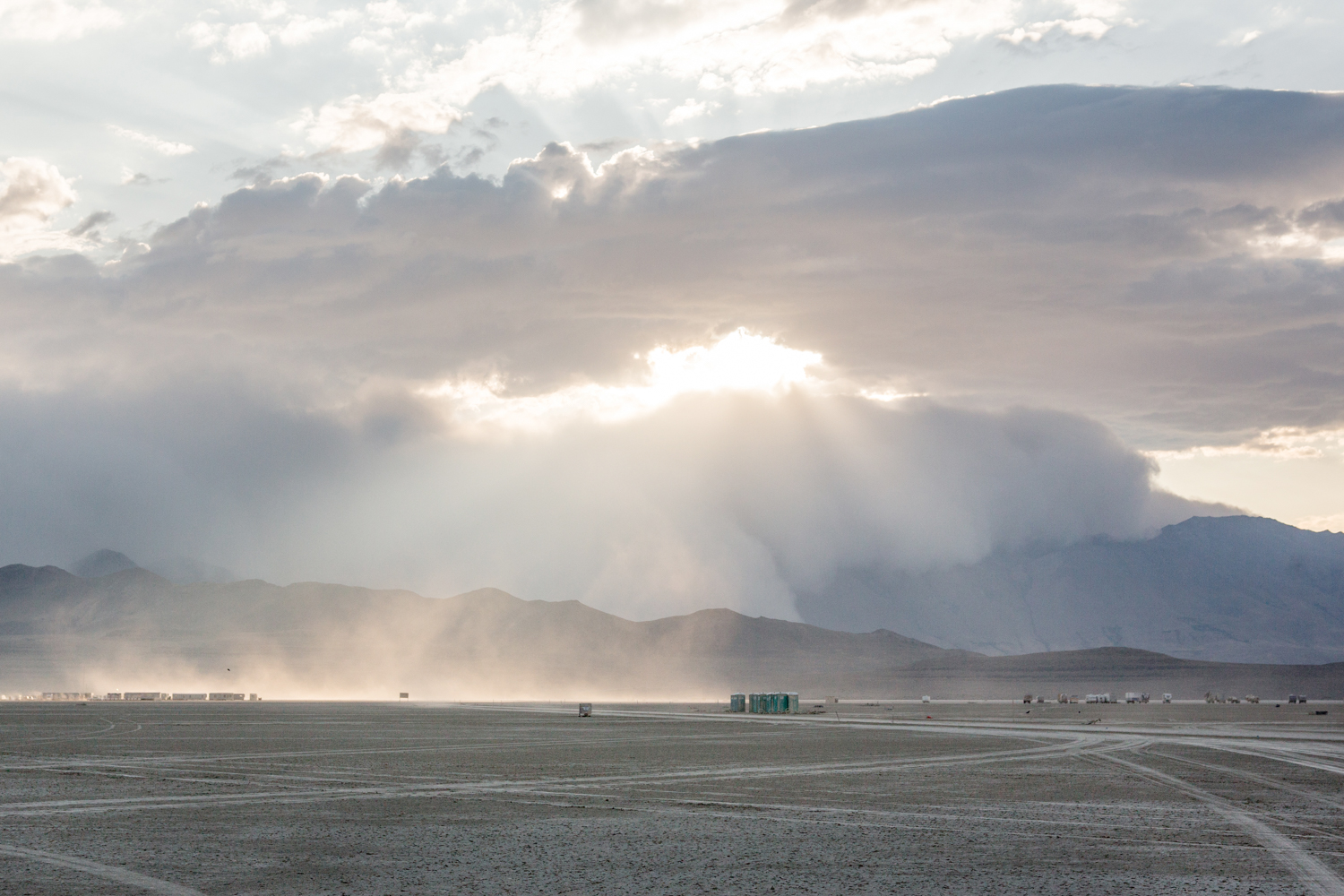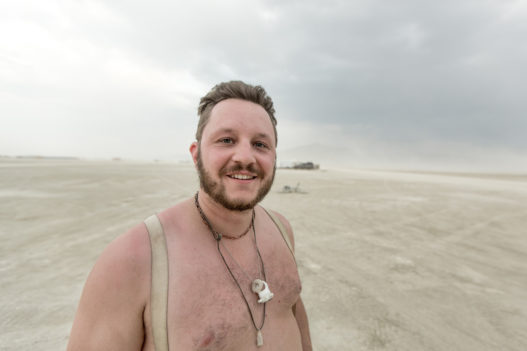
The end of Burning Man is almost as nebulous as the beginning, because it happens at so many different times for different people.
For most folks, the end came as you rattled down Gate road, washboard bumps shaking you silly as you plowed through deep drifts of dust.
For others, the end came a couple of weeks later, at the end of strike. Everything had been put back into containers and taken back to the ranch for next year. And everyone came together for de-Fence day, when nine miles of trash fence was rolled up and stored for next year.
And for some others, the end won’t come for several more weeks. The playa still must be MOOPed from one end to the other, and the Resto team started its work today. They’ll be looking for any stray bits of humanity that might threaten the “leave no trace” ethos of the event and jeopardize the BLM permit.
For us, though, the end came swiftly, suddenly, and decisively. We knew beyond any doubt that we had been in the desert long enough, and that it was most definitely time to go.
—

James and John, two Burners from Santa Cruz, have always been a little indeterminate about their departure date from Burning Man. Maybe that’s why they were still around on Tuesday after the event, on the outer edges of the city, sitting near a pop-up bar and waving at people to come have a beverage.
“The Last Bar Standing” was spray-painted across the front of their shade, and that’s pretty much what it was – the last bar standing. A few stragglers were making their way out of the city, and most of them didn’t stop, but there were a few who decided, oh, what the hell, one more adventure won’t hurt.
Mathew and Scott were two of the drop-ins, and Scott was behind the bar as we rolled up. The two of them had been there most of the day, because their station wagon broke down as they began their departure. But here’s where their story takes a decided Burning Man turn: Two nearby campers, both mechanics, volunteered to go to Reno to pick up a new radiator, then come back to the playa to install it. So as Mathew and Scott waited for them to return, they were making the best of a pretty good situation.
For Mathew, a first-time burner, this was the capper to an amazing week. “You know,” he said, “my expectations [for Burning Man] were so big, it was bound to break my heart … but nope.”
Scott was having a good time behind the bar, welcoming new arrivals and concocting refreshing beverages from what was left of the supplies. “I’ve been telling him forever that he’d make a great bartender,” Mathew said. And just before the burn, Scott had been fired from a job he hated, “so maybe now he’ll listen to me,” Scott said. We hope there’s an establishment in Portland that will give Scott a shot.
—
Stinger knew what she had found, but she wasn’t quite sure what to do with it.
Remarkably, in a place that is so fond of ritual and ceremony, no one had made much of a deal about pulling the Golden Spike out of the ground. As you probably know, the Golden Spike marks the spot where the Man is built. It is an actual spike, spray-painted gold, and a couple of hundred people take turns hitting it into the ground with a sledgehammer. The ceremony takes place at the end of July, and it marks the both the beginning and the center of Black Rock City.
But what happens when the Spike is no longer needed? Apparently … nothing. It is removed without much fanfare over the course of the Man build, or prior to the torching of the site on burn night.
But this year, the year of the Temple of the Golden Spike, the spike was never removed from its place in the floor of the playa. And now, almost a week after the Man and his pagoda had gone up in flames, and six weeks and a day after it had been pounded into the ground, here was the spike.
Stinger, rooting around in the ashes as part of her cleanup work, discovered it. And because she has good instincts, she didn’t pull it up right away – she went and found Coyote, the superintendent of Black Rock City, and asked what she should do.
“I was just going to pull it up and give it to Tony (Coyote),” she said. But Tony, also with good instincts and a sense of the moment, decided that he wanted to be there when it came out of the ground.
Coyote said, “It’s the first time we’ve recovered the spike since the last time the Man was standing on the ground,” which would have been in the late 1990s. “This’ll go to the Smithsonian,” he said, referencing an upcoming exhibit at the museum.
Stinger muscled the stake puller around the spike, rocked back and forth a few times, and just like that, the spike was free. There were only four people on hand to witness the occasion. And that seemed wrong, given the pomp and circumstance surrounding its planting in the ground. Maybe next year extracting the spike will be more of a thing, but for this year, it was just another indicator that it was time to go home. The circle of the season was complete.
—
Days after the event officially ended, the whiteouts that we had been dreading began to roll in, with the extra added attraction of rain. Nothing makes cleanup more difficult than putting everything away while it is covered in mud.
“Whiteouts are terrifying but amazing,” Allison was saying as she worked on the deconstruction of First Camp.
She was describing how she and Andrej and some others had gotten caught in a whiteout on the way back to camp, but that was just a tease of what was in store for us.
Larry Harvey his own self was a little late in leaving this year, too. He said he wanted to watch the desert come back, which was a lot of what the rest of us were doing, too. We had work to do, but we could also be amazed at how beautiful the ever-more-barren landscape was becoming. It was a form of decompression – the big event was over, and most everyone was gone, but there were many small moments to savor.
There’s a saying among DPW people that they are “Killin’ Time till Resto.” In Gerlach, the locals say, “Is it October yet?” That’s because right after Burning Man, the rocketeers come to town for their big annual launchings. And then the hunters come. The town stays hopping for most of September, and the people can get tired and burned out, just like they do on the playa.
When the cold winds blow, it is a relief. “Winter is the time to rest and sit on the money you earned in the summer,” the waitress at Bruno’s said. “My husband hates the snow, he’s from Florida, but I tell him winter is the time to slow down and enjoy yourself.”
—

During the tear-down, just as during the build, there’s a get-together of one kind or another, because our time together at summer camp is coming to an end. One night the Yellow Bike shop Recycle Camp will have a whisky and bacon party. Another night Illumination Village will have a block party to use up all their leftover propane. The next night there’s a kickball game at the Joint Operations Command center.
The big daddy of them all, though, is the Last Supper. It’s the last meal that will be served to DPW workers on the playa. The Commissary tent will come down the next day, and everyone will move back into town.
The Last Supper is an event of high fashion. People dig out clothes that they’ve kept wrapped in plastic for weeks so that they can look sharp for the Last Supper. There will be candlelight, and wine, and good food, and the best company.
But this year the good times at Last Supper lasted about 10 minutes before the desert started insisting that it was time to go home.
—

“I just want to say thank you,” Chaos was saying the next day. “Thanks for getting up and being here this morning. Everybody who’s here has proven that they can do this, that they’re tough, that they’re DPW.”
There were bleary eyes and there was lots of coughing at the morning meeting. But what was left of the city looked … beautiful, like it had been covered in new-fallen snow.
A blizzard of dust had roared through Black Rock City just as the Last Supper was starting. What had been a beautifully clear evening had turned into a lung-choking nightmare in a matter of moments.
You may have weathered a few dust storms yourself, so you may think you have an idea of what it was like. But this one was a monster – stronger, thicker and darker than any we’ve experienced. Coyote, who’s been coming here for more than 20 years, called it the worst he’d ever seen. Rusty of the Transpo team, who’s been coming to Black Rock for most of his life, said it was one of the worst he’d ever experienced, too.
So we won’t get hyperbolic, but we’ll simply say that this one was ridiculous. All those nice clothes? Trashed. The nice dinner of Cornish game hens? Covered with a quarter inch of dust in mere moments. And the good company? You could barely see who was sitting across the table from you. It was bad.
And then it got scary.
Flaps in the commissary tent started coming loose, and you began to wonder what it would be like to be trapped beneath all that canvas. “The air gets used up fast,” Coyote said. Of course you had no goggles, no flashlight, no knife, because hey, this was a fancy dinner, you wouldn’t need any of that.
Rangers and emergency service people came around with dust masks. Breathing was difficult, and getting worse. Then some people were led into the nearby Fluffers office, where you could close the door against the dust. Gate folks opened up some living containers and their main office, too. We followed lines of string hung in the darkness to get there.
A couple of hours later, there was a slight break and we made a run for our trailer near Center Camp.
—

So there was Chaos the next morning, thanking people for persevering, and reminding them that there still was work to do. “This is a different season than Burning Man,” he said. “We’re in September now, and it’s different out here. It gets cold, it’s windy … it’s unpredictable. … It could happen again. It could happen in the day, it could happen in the middle of the night. … So, just make good decisions when you’re out there, take care of each other. … Let’s just try to be safe and get the remainder of the work done.”
There was a ton of work to do the day after the big storm. The big “Move-a-palooza,” as Makeout Queen calls it, would see about 70 trailers towed from the playa to Gerlach. The city would be virtually empty by nightfall. But Cobra Commander tried to make sense of what happened the night before.
“Today’s instructions are simple, in case you did not get the subtle message from nature: Get the fuck out of here. … It’s time pack up and move off the playa.”
And so we did.
We’ll try to make sense of our time at Burning Man later. We’ll think the big thoughts, figure out the life lessons, try to make sense of the things we experienced. But for now, it was good enough to have reached clarity about one single thing: For us, it was time to go.























There has to be some sort of catch phrase for this “Spike to strike” ? Hope your end was not bitter.
Report comment
Playa Resto pulls up the T-stakes for the intersections, they have a last “golden” T-stake ceremony. So to do the whole DPW run, the saying is from Spike to T-stake.
Report comment
that works !
Report comment
*Recycle Camp throws the Whiskey and Bacon Party.
Report comment
noted in story, and thank you again
Report comment
Thought it was an intentional joke at first, not a correction.
Report comment
YBC started offering their space to Recycle Camp a year or two ago — the party had outgrown RC’s space.
[I’m not an official person – simply an attendee of a few years’ worth of parties]
Report comment
Ali Baba, that is incorrect. Bike Camp hosted it last year because of complicated reasons. Recycle Camp took it back again this year and we have no problem with capacity. Bike Camp doesn’t have the same infrastructure or living space we do. Next year at Recycle Camp!
Report comment
The Playa has her own fickle mind.
Report comment
and she’s quite demonstrative …
Report comment
The gratitude, love and appreciation I’m having now for you folks who are the first to arrive, the last depart and who suffer the most exposure to the elements which in this instance at the ‘Last Supper’ sounds horrific – is more than I can express here. After this years experiences I’m sure I’m not the only one questioning my commitment for next year. After reading this story I’m inspired and determined to show up just to honor you all I’ll never doubt the labor of love this demands from so many who get so little recognition for such selfless dedication. I love the shit outa all of you. Thank you , thank you, thank you.
Report comment
Second what you write Evan, so much gratitude to those whose efforts make the city possible.
Report comment
Thanks so much, Evan, and I am sure the crews appreciate your thoughts
Report comment
Thank you, John, for another year of excellent reports about our favorite place as it comes to life and fades again into dust. And thanks to everyone who makes it out there early and stays late to make it all happen.
Report comment
having done many RESTOS, i loved your story, can relate deeply,…thank you for the unsung
Report comment
Love for the last bar standing ❤️
Report comment
much love!
Report comment
That was undoubtedly the surliest morning meeting I’ve ever attended. My bike didn’t want to work after getting blasted with alkaline dust all night and I know I’m not alone when I say I wanted to sleep through my alarm that morning. I did appreciate Chaos’ validations that yes, we represented the hardened core of the Department, though and there’s the obvious truth that there still is a lot of work to do.
Resto is now faced with the challenge of finding the MOOP that got buried on that night under some pretty deep dunes that are now under a now rain-hardened shell of playa. We’re still here and still trying to save burning man. I’m still jealous of myself that I get to be a part of it.
Thanks, John!
Report comment
thank YOU L-Train
Report comment
And I thought the Tuesday evening after the event whiteout was bad…
Report comment
Wow and I thought I got the worst of it on both Tuesdays- The second one being what I’m pretty sure was a tornado that went from white out to complete blackness within minutes on the Tuesday following exodus. I was the last one standing in our camp doing the final mopping when out of the blue I saw it coming and took refuge in the RV. I actually was wondering if the RV would withstand the storm. It was nutz! But I guess there’s no limit our crazy storms can get. Wow!
Report comment
We can only hope the Indians will stop this farce next year by blocking the roads.
Report comment
Thank you for sharing. This article and its stories are immense and humbling. I am grateful to those who stayed and made it right.
Report comment
WOW!!
U guys ‘n gals R the best.
Thanks so very much!
Report comment
Such a good read John! Awesome job!
Report comment
This is really a sweet post, John. We camped across the street from the Last Bar Standing and I’m glad to see they are getting much deserved recognition.
Report comment
those two are a story in themselves, to be sure.
Report comment
Happen to have had the pleasure of camping with the mechanics next to the last bar standing for a few years. These guys will do anything for anybody anytime anywhere. Much love.
Report comment
thanks, Sarah, and feel free to give them a shout-out by name if you think they’d like it
Report comment
You guy’s are absolutely amazing. Thanks for all you do I am in awe of each and everyone of you beautiful beings :) xo
Report comment
I’m humbled by the dedication to the closing of our sacred “home”. Thank you to all of you who stay to complete this incredible effort under what this year were obviously an effort of perseverance. You are all another reminder of why we all dedicate ourselves to this annual pilgrimage..
Report comment
Thank you for this.
I think I just experienced the end of my burn this year, in reading your piece. Such a wonderful look into the people who are the last to leave. Bravo!
Report comment
Comments are closed.